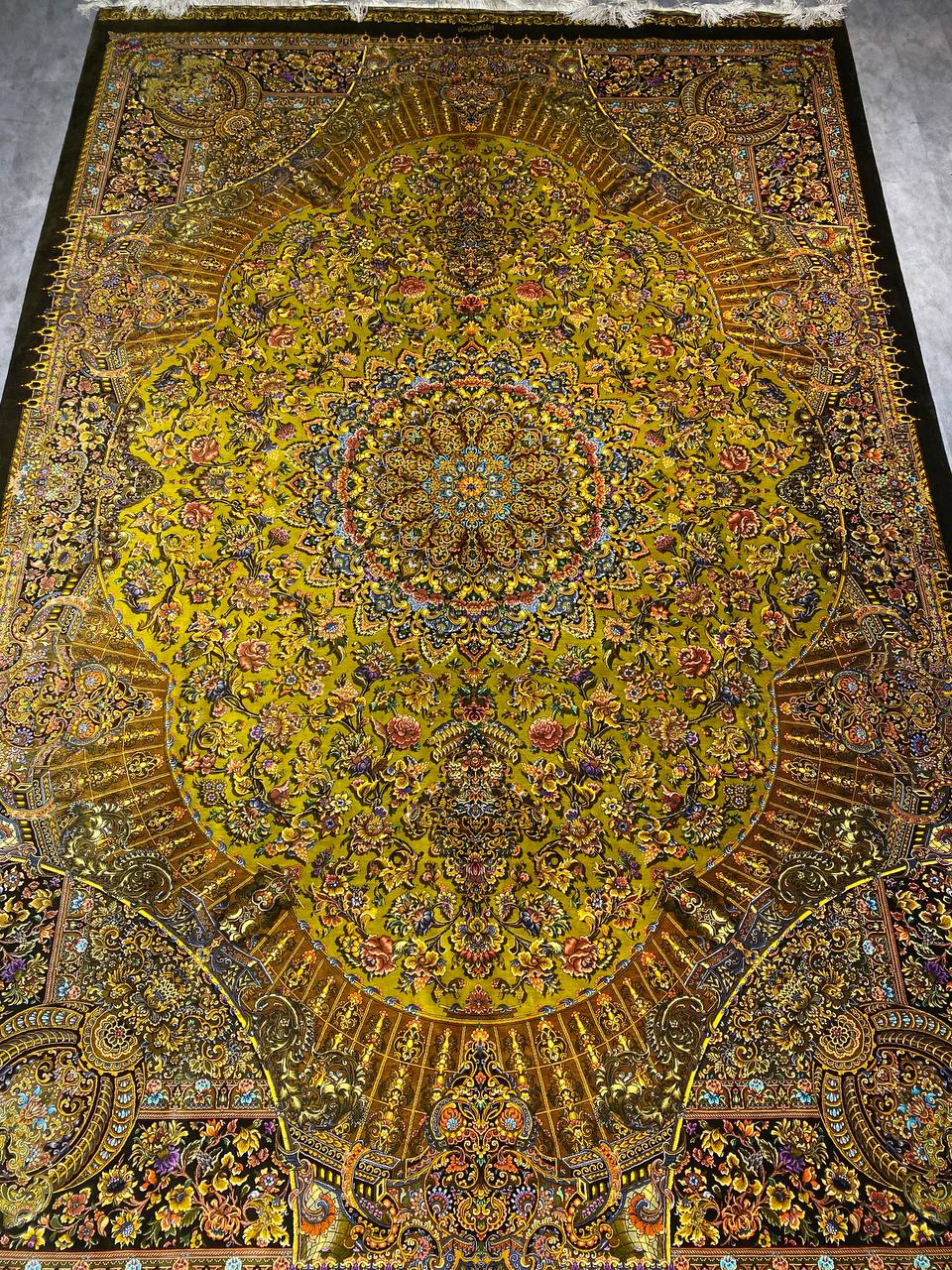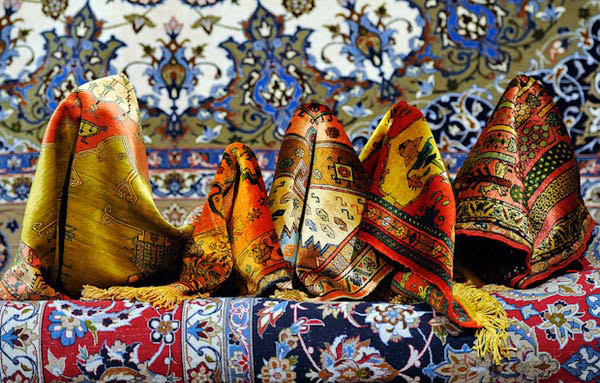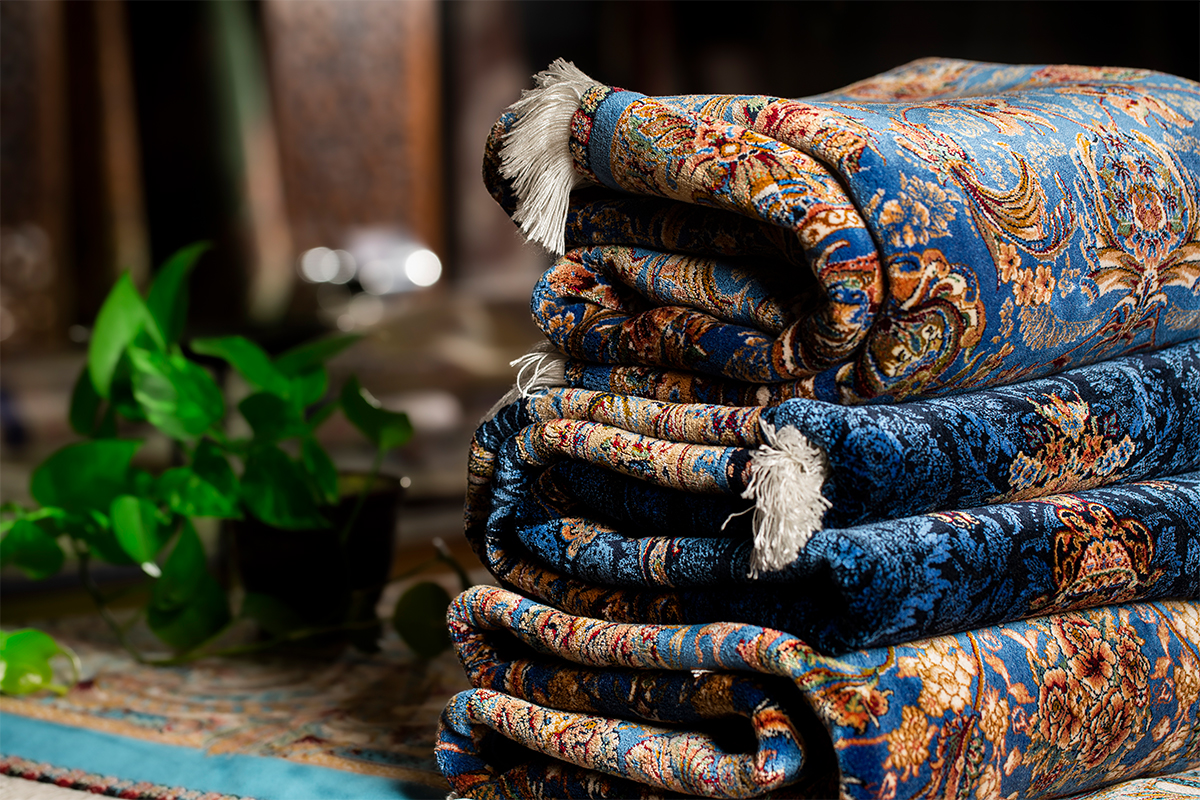persian handmade silk carpet is one of the most famous and valuable hand-woven carpets in the world. These carpets are produced using very soft and delicate silk fibers, and their hand-woven art in Iran dates back to ancient times. silk carpet gallery collection is the largest source for buying and selling Qom silk in Iran. In the following, we will discuss some types of persian silk carpets and the factors affecting the price of persian handwoven silk carpets:
1. Gulamim carpet
Golmim carpet is considered as one of the most famous symbols of Iranian art. These carpets are woven by Qashqai women in Golmim region, Razavi Khorasan province. Gulmeem designs are mostly based on flower and vase designs and use natural colors. Some examples of Golmim carpets are interwoven with detailed details.
2. Kashan carpet
Kashan silk carpet is one of the most popular types of Iranian carpets. These carpets are woven in Kashan city, Isfahan province and are famous for their high precision and impressive designs. Kashan carpets usually have imperial designs, Golestan maps and are inspired by Iranian classical examples. These carpets are produced with rich colors and different textures.
3. Nain carpet
Nain carpet is also one of the famous types of Persian silk carpet. These carpets are woven in the city of Nain, Isfahan province, and are inspired by the designs of Nain and surrounding cities. Nain’s carpet designs include geometric shapes, Golestan maps, arrangement designs and designs with Quranic influences. These carpets have vivid and diverse colors and are carefully and professionally woven.
4. Qom carpet
Qom silk carpet is one of the Persian silk carpets that is woven in Qom city, Qom province. These carpets are produced with high precision and using high quality silk fibers. Qom carpets generally have designs related to Qom, Quranic designs and geometric designs. Qom carpet designs generally show old Iranian ways and influences.for Buying Qom hand-woven persian silk carpets contact us .
5. Cashmere silk carpet
Cashmere silk carpet is one of the well-known types of Iranian carpet. These carpets are produced in Kashmer city, Razavi Khorasan province. The cashmere silk carpet reproduces some of the ancient silk patterns and includes designs such as Sasanian splendor, epic maps, and flower and vase designs. These carpets are woven using natural colors and special techniques.
Types of thread used in persian handmade silk carpet
Iranian handmade silk carpet is made of high quality silk threads. In the following, I will mention some of the threads used in the Iranian handmade silk carpet:
1. Raw silk thread: These threads are obtained from natural silk fibers and are used as the main material for silk carpet weaving. These yarns are very soft and have a smooth and shiny texture.
2. Cotton silk thread: Some silk carpets use cotton silk thread instead of raw silk thread. These threads contain a mixture of silk and cotton fibers and increase the strength and stability of the carpet.
3. Silk thread with natural colors: Some of the threads used in Iranian handwoven silk carpets are obtained from natural colors. In this method, natural materials such as roots, plants, fruit peels and insects are used to dye yarns. This method creates vivid and permanent colors in the carpet.
4. Silk thread with artificial colors: Some Iranian silk carpets are made from silk threads with artificial colors. In this method, artificial and chemical dyes are used to dye the threads. This method can bring more vivid colors and variety in the carpet.
The amount and type of threads used in Iranian hand-woven silk carpets are determined by weaving experts. Each of these threads has special properties and characteristics that contribute to the beauty, softness and shine of the silk carpet.
Types of designs and maps of persian handmade silk carpets
Iranian hand-woven silk carpets are produced with various designs and patterns. These designs and maps are often inspired by ancient and contemporary Iranian culture and art, nature, the Quran, and religious and philosophical ideas. Below, I refer to some types of Iranian handmade silk carpet designs and plans:
1. Flower and vase designs: Flower and vase designs are among the most popular designs in Iranian silk carpets. These designs include flowers, petals, leaves, and flower branches that are woven into the rug in fine detail and vivid colors.
2. Geometric designs: Geometric designs are also widely used in Iranian handwoven silk carpets. These designs include lines, geometric shapes such as triangles, squares, rhombuses and circles. Geometric patterns are also very popular in modern rugs.
3. Central designs: In some silk carpets, designs are placed in the central part of the carpet, which are placed as the focal point of attention. These designs may include symbols, Chinese motifs, Persian letters, slogans and artistic images.
4. Imperial designs: Imperial and classic designs are also used in handwoven Iranian silk carpets. These designs are inspired by patterns and roles that were used during the rule of Iranian kings such as the Sassanids and the Safavids.
5. Golestan designs: Golestan designs are also known as one of the most popular designs in Iranian silk carpets. These designs are inspired by the collection of flowers, leaves, branches and grasses of flower gardens and are woven into the carpet as an arrangement.
6. Quranic designs: Iranian handmade silk carpets are inspired by designs and maps that are related to the Holy Quran. These designs include Quranic verses, names of God, religious symbols and images related to Quranic stories.
These are just a few examples of designs and patterns used in handwoven Iranian silk carpets. Skilled Iranian artists and weavers can also design new and creative designs for their silk carpets.
Conventional sizes for buying persian handwoven silk carpets
Iranian hand-woven silk carpets are produced in various sizes. The size of carpets is usually determined based on different uses and needs of customers. Below, I mention some of the conventional sizes of Iranian silk carpets:
1. 60 x 90 cm: This size is usually used for small and decorative carpets. These types of rugs may be placed on small tables, walls or chair backs as decorations.
2. 120 x 180 cm: This larger size is suitable for use in small spaces such as sofas, antes and bedsides.
3. 150 x 240 cm: This size is usually used in small to medium spaces such as bedrooms, living rooms, and small areas such as entrance areas.
4. 200 x 300 cm: This medium size is suitable for use in larger spaces such as halls, large reception rooms and public spaces.
5. 250 x 350 cm: This size is suitable for larger carpets and use in larger spaces such as living rooms and exhibitions.
In addition to these sizes, special sizes can also be ordered for Iranian handmade silk carpets. Also, silk carpet may be produced in the form of track carpets, round carpets, or rectangular carpets with different sizes and dimensions.
It is recommended that before buying an Iranian hand-woven silk carpet, you should specify the dimensions and size you need and familiarize yourself with the different samples in the silk carpet gallery so that you can make a better choice.
What is the index of hand-woven carpet and how is it calculated?
Carpet index can be introduced as one of the most important characteristics of a handwoven carpet, which can be used to determine the quality, price, and elegance of a carpet to some extent. We are all familiar with the name density and understand its meaning perfectly, but this density has one meaning when it is used in machine-made carpets and another meaning in hand-woven carpets.
Linguistically, Raj means knot in carpet weaving in Tabriz city, but conceptually it is the same as Rajshmar carpet, and if we want to express it, it is necessary to introduce some prerequisites for you before that, so that you can fully understand the definitions. do.
To buy and inquire about the price of persian handmade silk carpet, contact us at silk carpet gallery boutique collection






Recent Comments